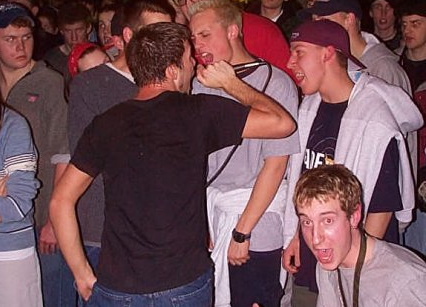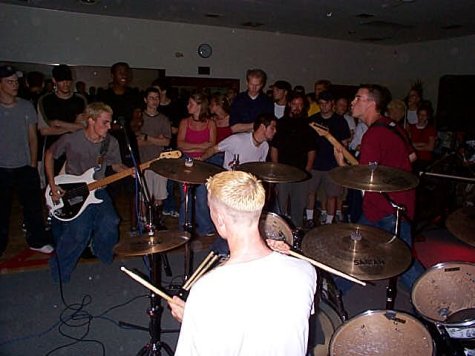 Music
Music
Here's proof that we're not ready for the emo revival
by Mark Teo
February 27, 2014
Photo: Saves the Day at what we believe is the Toronto JCC, via Ontariomusic.com
Unless you’re been completely ignoring the music Twittersphere—and if you have been, daps—you’d know that the emo revival is in full swing. Indeed, emo isn’t the pejorative term is was even a year ago: Bands like The World Is A Beautiful Place & I Am No Longer Afraid To Die are suddenly getting 7.8 ratings on Pitchfork. Two days ago, VICE published a where-are-they-now story that included names that’d normally receive barfy faces in their reviews: Thursday, Thrice, Finch, The Used. Heck, Noisey even hired the fucking Jaded Punk Hulk guy as an editor (great call, guys), and now, he’s writing stories titled “There’s No Emo Revival, You Just Stopped Paying Attention.”
Of course, we dispute the above headline: There’s clearly been an emo revival, because two years back, it’d be completely laughable for any publication—even fucking Alternative Press—to write about a Saves the Day set at a Mexican restaurant. Even if Through Being Cool is a stone-cold classic.
So yes, we do believe an emo revival’s taking place. But that leads to another, perhaps more important question—have we forgotten why we buried the genre in the first place? Have we forgotten the latent absurdity of emo? Are we ready for an actual emo revival—one that extends beyond Bleed American?
Are we ready to remember the era of Grade that preceded the photo below—the era when Kyle Bishop had dreadlocks?

I’m wagering that the answer is no. And Abandoned 7″s, a Tumblr that’s been recently causing a splash, only confirms it.
Loosely, the blog collects, reflects, and mocks emo 7-inches from the ’90s—it focuses on the middle of the genre’s Venn diagram, the soft centre between Jimmy Eat World and Guy Picciotto. It’s an essential part of the genre’s history, and if you dig just a little bit past Thursday’s War All the Time, you’ll find the era easily: Spun off the hardcore scene, it was part heart-on-sleeve earnest, part D.I.Y. obsessed, and all weapons-grade embarrassment chills.
Why? Because there was crying. Lots of crying. Here’s a snippet from the post about Rent America, who, like many bands of the era, literally burst to tears onstage.
“At another fest their singer apparently went on a very very long thing about taking a walk after the rain, and seeing all of the worms that had come out during the storm and then died. Just on and on about these dead worms. And he starts sobbing as he’s talking about the worms, and then the band starts playing, and he’s screaming, about worms maybe? No idea.
To translate: Despite the Clinton-era’s unprecedented prosperity—and the emo scene’s American roots in upper-middle class, often Midwestern America—these twerps still found things to complain about. Namely, about the injustices of worms that die after a rainfall.
Next, there was the inexplicable obsession with the Krishna movement (partially inspired by NYHC’s foray into the religion, with Shelter leading the way). Punk and hardcore typically fashions itself to be anti-religion—often aggressively so—but Krishna was an exception. One that can’t be explained. From the blog:
“You know when old hippies are trying to rationalize having been Weather Underground sympathizers or something along those lines and they are like ‘You don’t understand….those were crazy times!’ That should be our collective line on ever having entertained any of this Krishna Consciousness hardcore stuff even for a second. I don’t think you could ever comprehend this phenomenon without having ‘been there, mannnn.’ I was and I still don’t understand it. Why didn’t we laugh these people off the stage?? I guess I talked about this in the Green Rage post a little, but as a community we were perhaps a bit too welcoming.”

Photo: Fastbreak, via Ontariomusic.com
Then, there was the aggressively political side of things—a crafty, zine-oriented culture emerged from the movement, often focused on animal liberation and gender equality. And we could all agree on gender equality—though, as Abandoned 7″s notes, things got sticky (pun not intended) when girls actually started participating in the male-dominated scene.
“I remember the budding feminist in me was always bothered by the fact that every time there was a woman in a hardcore band (we used the term ‘girl’ at the time, of course, being children) dudes would NOT shut up about how hot they were. Oh my god dude, did you see the bass player in ___? SO hot. Of course instead of engaging with this in some kind of critical analysis of the male gaze and asking my friends to consider the consequences of this limited way of thinking about women, my challenge to this was usually ‘C’mon, dude, she’s not that hot.’
This is why it’s hard for me to get on board with people who pull their hair out over what a half naked Miley Cyrus going around licking things is doing to the psyche of our impressionable youth. Miley Cyrus could be up there in JNCOs, Airwalks and a giant t-shirt and there’s still going to be a million teen boners about it. That’s just life.”
So, we can all agree that Texas is the Reason is amazing. But are we really ready to go back into emo’s roots? Are we ready to embrace overdramatic teens in chokers, JNCOs, and bleached-blond ski jump haircuts? Because if so, we need to adopt the mindset that Abandoned 7″s discusses, one that only could’ve existed in an era past: “[T]here’s something you have to understand about hardcore/punk/whatever- at least as it existed in the 90s: it was perfectly normal to be really into something- a band, a style, a genre, etc, while at the same time recognizing that it was super absurd and stupid and horrible.”
We ain’t ready.

Photo: Maharajh, via Ontariomusic.com





